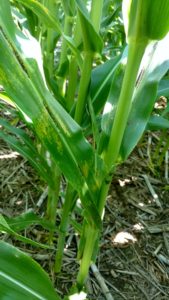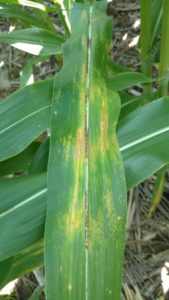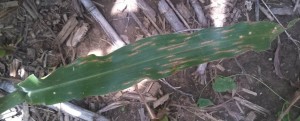With no reports of southern rust in Tennessee or to the south, it is a relatively quiet disease season in corn, with the exception of grey leaf spot and physioderm brown spot in Tennessee corn.
In my own research plots I’m seeing grey leaf spot in the lower canopy and hits of physoderma brown spot. While physoderma brown spot (image 1-2) is not of too much concern, I have also gotten reports of it in production fields. It is of concern if it gets on the stalk and causes rot. It is easily identified by the dark spots in the mid-rib of corn leafs (image 1-2).


Grey leaf spot (image 3-4) could still warrant a fungicide application in certain situations, but on the whole it doesn’t look like there is much, if any disease (especially southern rust) threatening corn in Tennessee.


Foliar fungicide applications in corn is more likely to provide a response in yield when disease is present or there is significant risk of disease, weather conditions favor disease development, the field is corn after corn, and a disease susceptible hybrid is planted. Research data from University of Tennessee and other universities has continuously found these factors to strongly influence the magnitude and consistency of yield response to a foliar fungicide application in corn.
Deciding to apply a fungicide to corn should be based upon multiple factors including:
- Disease presence
- Weather conditions
- Cropping history
- Hybrid disease susceptibility
When factors warrant a fungicide application, the application timing that has provided the most consistent yield response over non-treated corn is a fungicide application at VT or R1 growth stages (tasseling to pollination).
Major corn diseases are favored by humid conditions, so the edges of fields will not be the place to scout. Within fields, especially low spots that hold moisture are good areas to scout for disease as it may develop in those areas first. Be on the lookout for lesions and use the resources on UTcrops.com and particularly under Corn Diseases in the photo gallery (Corn Diseases in Tennessee) which contains disease images and weather conditions that favor disease development (soon to be on mobile friendly field guide at guide.utcrops.com). For you tweeters out there, tweet a picture of any corn diseases you’re seeing, the disease name, and county and state to @corndisease.

